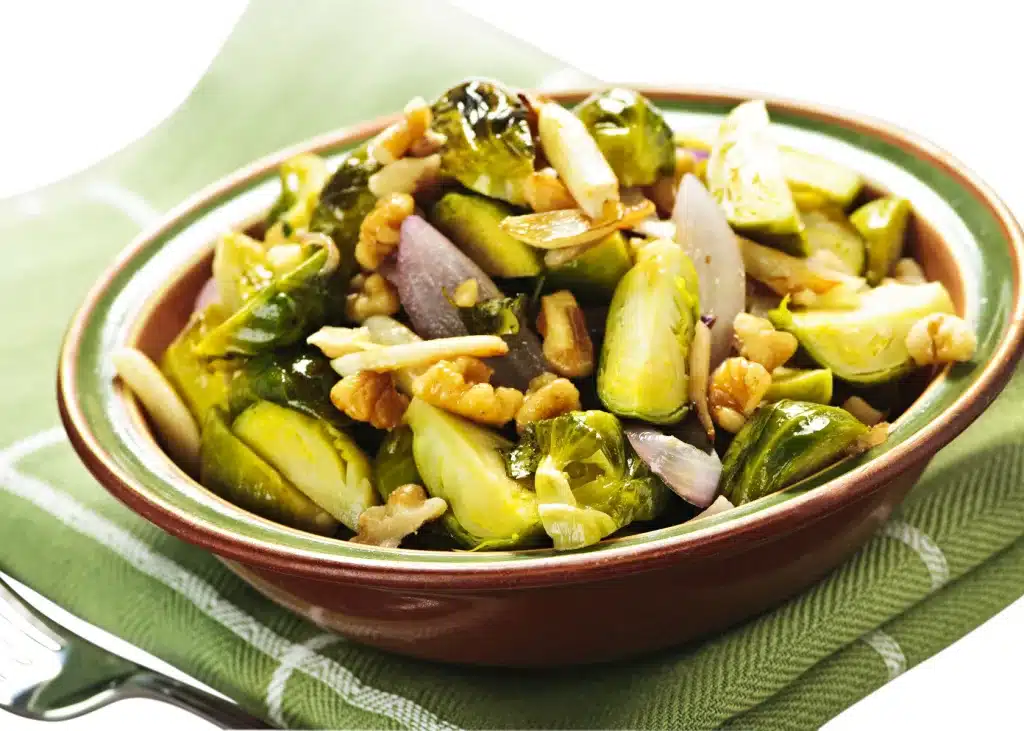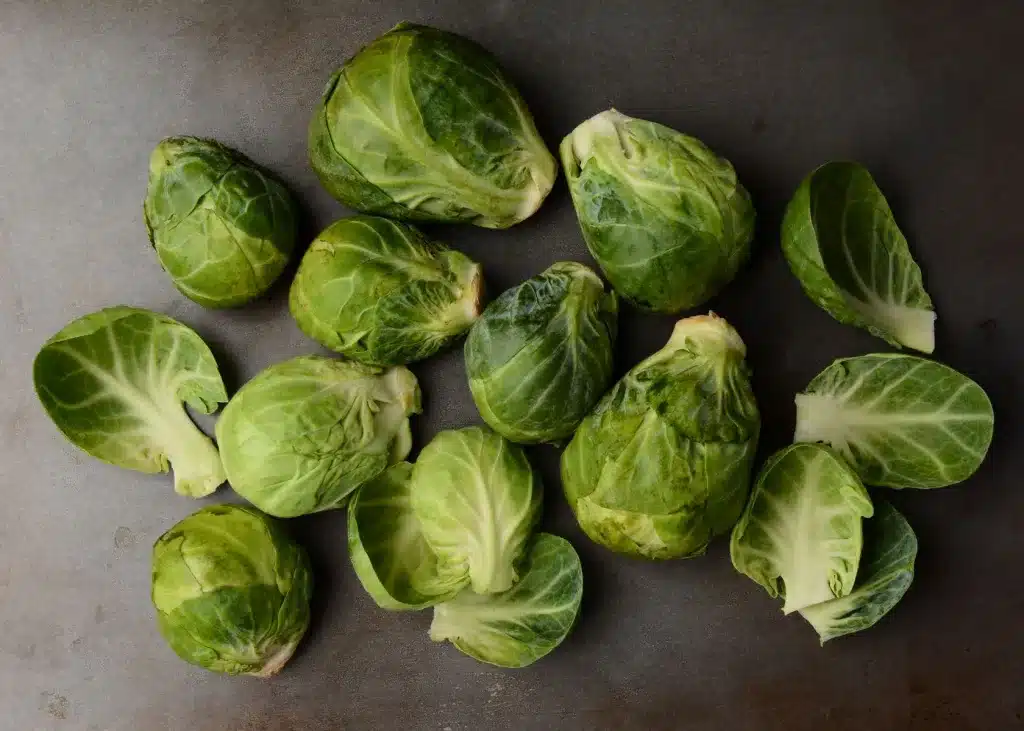If you’ve caught yourself staring at a bunch of dirt-clad Brussels sprouts and sighing in anticipation that how to clean brussel sprouts, this article is for you!
There’s just something about these little green gems that seem to hold onto grit with an iron grip. But let me assure you—the task is far less grueling than it might appear.
I understand the feeling all too well—you’re standing in your kitchen, Brussels sprouts piled on the counter, wondering if there’s a trick to banishing that stubborn dirt.
Well, I’m happy to share some good news: after much trial and error, plus diving into research for those best-kept secrets, I’ve discovered surprisingly simple methods for making sure your veggies are spotless.
What I’ve found is this: With a bit of savvy prep work and my easy-to-follow guide—crafted from personal experience—cleaning those Brussels sprouts won’t just be manageable; it will practically become second nature.
Now here’s an insider tip before we roll up our sleeves: giving them even just a short soak can work wonders in shaking loose any concealed grime nestled between those tight leaves!
So grab your apron and get ready for some clean greens—as promised, we’ll walk through each step together to perfectly select, trim, bathe, scrub down (gently does it!), rinse thoroughly—and indeed—dry off those sprouts with finesse.
Key Takeaways
- Choose firm and green Brussels sprouts without yellowing leaves to ensure freshness.
- Trim the stems and soak the sprouts in water to loosen dirt before using a vegetable brush under cold water for a thorough cleaning.
- For an extra deep clean, create a vinegar solution (one part vinegar to three parts water) to remove additional dirt and debris.
- Always inspect the cleaned Brussels sprouts carefully for any remaining bugs or impurities that might be hidden among the leaves.
- Dry off the Brussels sprouts after rinsing to prevent dilution of flavors and achieve a crispy texture when cooking.
Understanding Brussels Sprouts

Brussels sprouts are small, leafy green vegetables that belong to the cabbage family. To select the best Brussels sprouts, look for firm, bright green ones without any yellowing or wilting leaves.
What are Brussels sprouts?
Brussels sprouts are like tiny cabbages packing a punch of nutrients and flavors. Each little green ball grows on a long stalk, and when they’re ready to harvest, I snip them right off. They’re popular in cooking vegetables because you can roast, steam, sauté them, or even enjoy raw in salads.
To make sure I’m eating clean and healthy Brussels sprouts, I start by giving them a good cleaning. I trim their stems and remove any yellow leaves before washing them thoroughly. It’s essential for food hygiene and safety that every nook gets attention during the rinse process.
After soaking the sprouts in water to loosen grime, I brush away dirt with a vegetable brush then rinse under cold running water until all traces of soil are gone.
I always ensure they’re moisture-free by draining excess water after rinsing fresh vegetables like these sprouts – it’s key for recipes where crispy textures matter like roasted Brussels sprouts!
The goal is not just about getting rid of visible dirt; it’s also crucial to wash out potential bugs using kitchen techniques such as vinegar solutions which have become part of my routine for vegetable preparation.
How to select the best Brussels sprouts
After understanding what Brussels sprouts are, it’s important to know how to select the best ones for cleaning. Here are some tips for picking out the freshest Brussels sprouts:
- Look for firm and compact heads without any signs of wilting or yellowing leaves.
- Choose smaller-sized Brussels sprouts as they tend to be sweeter and more tender than larger ones.
- Inspect the outer leaves for any discoloration or damage, opting for those with crisp, vibrant green outer leaves.
- Avoid selecting Brussels sprouts with a strong cabbage-like odor, as it may indicate they are past their prime.
- Gently press on the heads to ensure they feel dense and heavy, indicating freshness.
- Consider purchasing organic Brussels sprouts to minimize exposure to pesticides and chemicals.
Preparing Brussels Sprouts for Cleaning

Before cleaning the Brussels sprouts, it is important to trim the stems and soak them in water to loosen any dirt or debris. This will make it easier to clean and ensure that they are ready for cooking.
Trimming the stems
I trim the stems of Brussels sprouts to remove any brown or wilted bits. This helps ensure that only the freshest part of the stem remains, making it easier to clean and prepare them for cooking.
Once trimmed, I soak the Brussels sprouts in a bowl of water to help loosen any dirt or debris from between the leaves. This step is crucial in ensuring that my Brussels sprouts are thoroughly cleaned before cooking.
After trimming and soaking, I rinse my Brussels sprouts under cold running water and then drain them well. This process removes any remaining dirt and ensures that they’re ready to be used in my favorite recipes.
Soaking the sprouts
After trimming the stems, soaking the sprouts is the next crucial step in preparing Brussels sprouts for cleaning. Submerging the sprouts in a bowl of cold water will help to remove any remaining dirt or debris.
Letting them soak for a few minutes allows the water to rinse off any soil particles that may have nestled deep within the tightly packed leaves.
Soaking also aids in loosening any stubborn dirt, making it easier to clean thoroughly. This simple yet effective method ensures that your Brussels sprouts are free from impurities before moving on to the final steps of rinsing and drying.
How to Clean Brussels Sprouts

To clean Brussels sprouts, start by using a vegetable brush to gently scrub the surface under cold water. Rinse them thoroughly and then drain and dry them before cooking.
Using a vegetable brush
To thoroughly clean brussel sprouts, I prefer using a vegetable brush to gently scrub the surface and remove any stubborn dirt or debris. After rinsing the sprouts under cold water, I take the brush and carefully work it over the entire exterior of each sprout to ensure they are completely clean.
This method effectively removes any lingering impurities and prepares them for cooking or consumption, leaving me with fresh and impeccably cleaned produce.
Once the Brussels sprouts have been brushed and rinsed, it’s essential to drain them well before proceeding with any additional preparation steps. Next, we can move on to “Removing Dirt and Debris” where we will explore using a vinegar solution for an extra level of cleanliness.
Rinsing under cold water
Rinsing Brussels sprouts under cold water is an essential step in the cleaning process. After trimming the stems and soaking the sprouts, I place them in a colander and rinse them thoroughly under cool running water.
This simple but effective method helps to remove any remaining dirt or debris from the outer leaves of the Brussels sprouts, ensuring that they are clean and ready to be cooked or eaten.
Draining off excess water and patting dry with a paper towel completes this stage of preparing fresh Brussels sprouts for use in various recipes, such as steaming or sautéing. Next, let’s move on to removing dirt and debris from these nutrient-rich greens.
Draining and drying
After rinsing, I gently shake the colander to remove excess water from the Brussels sprouts. Then, I spread them out on a clean kitchen towel or paper towel in a single layer to air dry for a few minutes.
This step helps to ensure that the sprouts are completely dry before using them in any recipes, especially if they will be roasted or sautéed.
Drying Brussels sprouts is essential as it prevents water from diluting flavors and interfering with cooking methods such as roasting. After draining and drying, the sprouts are ready to be used in delicious recipes like sautéed Brussels sprouts with garlic and lemon or roasted balsamic Brussels sprouts.
Removing Dirt and Debris

After soaking and rinsing the Brussels sprouts, it’s essential to remove any remaining dirt and debris. A vinegar solution can help eliminate stubborn dirt, while a thorough visual check can ensure no unwanted bugs are lurking on the vegetables.
Using a vinegar solution
To remove any remaining dirt and debris from Brussels sprouts, I suggest using a vinegar solution. Create a mixture of one part white vinegar to three parts water in a large bowl or basin.
Gently submerge the Brussels sprouts in the solution and let them soak for about 5-10 minutes. After soaking, rinse the sprouts under cold running water to wash away any lingering vinegar taste.
This simple method effectively removes impurities and ensures that your Brussels sprouts are clean and ready to be prepared for your favorite recipes.
Checking for bugs
After rinsing the Brussels sprouts with a vinegar solution, it’s essential to inspect them for any bugs or debris. Look closely at the crevices between the leaves and along the stems.
Gently shake the sprouts under cold running water to dislodge any insects, if present. Keep an eye out for small pests, such as aphids or caterpillars, as they are common on Brussels sprouts.
Use a vegetable brush to carefully remove any remaining dirt or tiny creatures before proceeding with cooking or storing your cleaned produce.
Frequently Asked Questions

What’s the best way to clean Brussel sprouts?
Start by rinsing your Brussels sprouts in cold water to remove any dirt, then cut off the stems and any yellow leaves, and give them another quick wash before cooking.
How do you get rid of bugs in Brussel sprouts?
Soak your Brussel sprouts in a bowl of cold water for a few minutes; this will help any hidden bugs float to the surface where you can easily remove them.
Can I just rinse my Brussel sprouts under tap water?
Yes, rinsing Brussels sprouts under running tap water while rubbing their outer layers is an effective method for cleaning vegetables like these leafy greens.
Should I dry my Brussels sprouts after washing them?
After washing, gently pat your Brussels sprouts dry with a clean cloth or paper towel before you move on to cook them, whether you are steaming or sautéing.
Why is it important to clean Brussels well before eating?
Cleaning fresh produce such as Brussels thoroughly ensures that you remove any remaining dirt or germs so that your eating experience is both healthy and enjoyable.
Conclusion
In summary, cleaning Brussels sprouts involves simple steps such as trimming, soaking, rinsing, and draining. These practical methods ensure the efficient removal of dirt and debris from the vegetables.
Have you considered implementing these easy techniques to clean and prep your Brussels sprouts for cooking? By following these strategies, you can elevate the quality of your produce and maintain a healthy kitchen routine.
Applying these cleaning tips can lead to fresher and more nutritious Brussels sprouts for your culinary creations. Ready to enjoy cleaner and tastier Brussels sprouts in your dishes?

